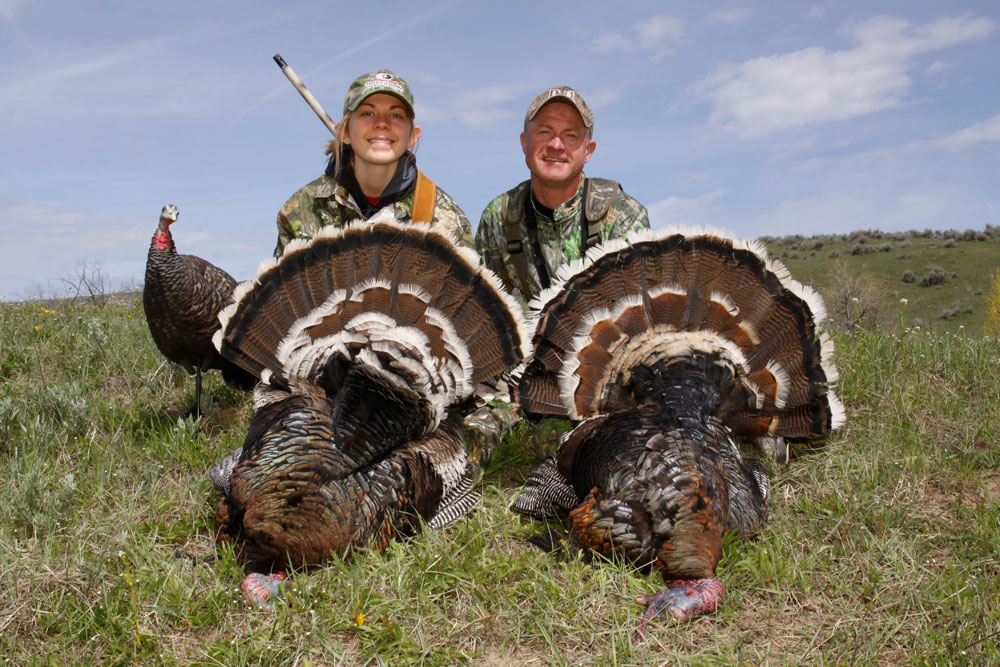provided by John E. Phillips
Mossy Oak ProStaffer Mark Kayser grew up in South Dakota and harvested his first turkey in 1983. He’s spent most of his life there but recently moved to Wyoming. “We hunt the Merriam’s subspecies of wild turkeys and also have some intergrade turkeys. For example, in South Dakota, farm turkeys from the eastern and Rio Grande turkeys were released and crossed with the native Merriam’s. Most of the turkeys we harvest in South Dakota and Wyoming have white-tipped tail feathers and white-tipped feathers on their backs, although some turkeys have sandy-colored, yellow-tipped feathers on their tails and backs.”

Mossy Oak: Often the Merriam’s gobbler will have a flock of hens with him when he goes to the roost. If those hens fly down with the gobbler and are able to take that tom away from you and your decoy, what do you do?
Mark Kayser: That happens quite a bit. As soon as I know that the Merriam’s hen has pulled that gobbler away from me, I quit calling. Sometimes, when I shut up, the gobbler will return after he’s gone a certain distance - just to check me out because more than likely, I’ve previously been giving him excited calls like a hen that wants to breed. He knows that he always can find that other flock of hens, because they’ll keep talking while they’re walking.
Last season, while my wife Sharon and I were hunting, this exact problem occurred. I used my binoculars to watch the gobbler we had set up on take a walk-off with two hens. They didn’t go very far before they left the gobbler by himself. For a while, he stood there looking very confused, until finally he decided to follow one of the two ladies. He crossed under a fence, and about 20 minutes later, I saw him through the timber coming back toward us. He started gobbling after he came back under the fence. I figured he was trying to call to that hen (me) that he’d left when he went off with the other two hens. I still didn’t call to him. He was looking around to see if that hen was moving back to him, while he walked along the edge of the creek bank where I’d set up. Sharon got a perfect 30-yard shot on that tom.
Over time, I’ve learned that calling to a Merriam’s that’s already coming to me isn’t effective. Once I call to one turkey that’s headed in my direction, I’m giving him too much information about where I am. At that point, he’ll stay right where he is and expect that hen (me) to come to him. However, when she doesn’t come to him, he’ll continue to walk to the area where he’s last heard her. The only time I’ll call game – an elk, a coyote or a turkey - while they’re coming to me is when I want them to stop for me to take a shot.
When the gobbler doesn’t come back to me fairly quickly, I’ll make a big loop around him and the hens, set up in front of them and use a different call to get the gobbler’s attention. Sometimes this process may take me up to an hour or more. By that time, that tom may have forgotten about the hen that’s been calling to him once he’s come off the roost. So, by using a different call and sounding like an excited hen, oftentimes I can pull that gobbler out of the flock and get a shot.
Mossy Oak: What calls are you using for Merriam’s?
Mark Kayser: I’m using a diaphragm (mouth call) made by Rocky Mountain Hunting Calls. I carry various mouth calls, so I can change calls to sound like I’m a different hen. I’ll also use a slate pot call from time to time.
To learn more about Mark Kayser, visit his Facebook page at https://www.facebook.com/markkayseroutdoors/.




























